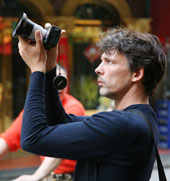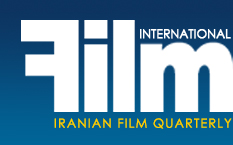|
Interview with Eigil Bryld, director of photography of “In Bruges”
Trying Not to Laugh Is the Hardest Part
by Javad Rahbar
|
 In Bruges, the first feature film by the Irish playwright, screenwriter and director, Martin McDonagh, has received critical success across the world winning several awards among them a best actor Golden Globe Award for Collin Farrell as well as best screenplay nomination for the screenwriter, Martin McDonagh. The movie was a favorite in Iran on DVDs in 2008. Therefore, we have turned to its director of photography, Eigil Bryld, to share with us his insights on the film and memories from making an art house movie in the ancient and small Belgian city of Bruges. Bryld is not a stranger to Iran and Iranian cinema. He has some Iranian friends and some of his closest friends have visited Iran as well. In Bruges, the first feature film by the Irish playwright, screenwriter and director, Martin McDonagh, has received critical success across the world winning several awards among them a best actor Golden Globe Award for Collin Farrell as well as best screenplay nomination for the screenwriter, Martin McDonagh. The movie was a favorite in Iran on DVDs in 2008. Therefore, we have turned to its director of photography, Eigil Bryld, to share with us his insights on the film and memories from making an art house movie in the ancient and small Belgian city of Bruges. Bryld is not a stranger to Iran and Iranian cinema. He has some Iranian friends and some of his closest friends have visited Iran as well.
He has also had a short and indirect experience with the Iranian cinema when he shot Before the Storm for the award-winning Swedish-based Iranian director, Reza Parsa. Before the Storm, Parsa's first feature film is a suspense thriller which has achieved great success with critics around the world.
A brief look at Bryld's resume shows that he started shooting movies in his homeland, Denmark, in 1996 with three consecutive Danish movies. Then, he continued shooting films mostly in Britain and the United States. His major feature projects include Becoming Jane (Julian Jarrold, 2007), The Half Life of Timofey Berezin (Scott Z. Burns, 2006), Kinky Boots (Julian Jarrold, 2005), The King (James Marsh, 2005), Oh Happy Day (Hella Joof, 2004), To Kill A King (Mike Barker, 2003), Före Stormen/Before the Storm (Reza Parsa, 2000) and Wisconsin Death Trip (James Marsh, 1999). The Scotland section of The Last King of Scotland (Kevin MacDonald, 2006) has also been shot by Eigil Bryld.
Bryld is also interested in visiting Iran to see the country and probably watch some Iranian movies. The following interview has been done on September 23, 2008.
Film International: Let's start with your background.
Eigil Bryld: I'm a Danish cinematographer. I'm 37 years old. I live in New York with my family. I've recently moved to this city. I mostly work in UK and in the United States. I've done a few Danish films but it was a long time ago.
FI: How did you get involved in this movie, In Bruges?
EB: I was shooting a film in Ireland called Becoming Jane (Julian Jarrold, 2007) with the producer called Graham Broadbent and he introduced me to Martin McDonagh. Before In Bruges, Martin had only done a short film; a very successful short film called Six Shooter (2006), which won an Academy Award but he really didn't have real experience with feature films. He came to Ireland – he's from Ireland as well – and I met him there. There, we talked about how to approach the film, how to prepare for it, how to use storyboard, how much one should plan ahead, and how much one should leave for improvisations. I met him initially there and a few months later, we met in London and talked about the film. So, it initially started through the producer of Becoming Jane, who has also produced In Bruges.
FI: In those initial talks you just mentioned did you discuss specific locations of Bruges for shooting? Did Martin McDonagh have special ideas about the city and its historical monuments?
EB: Yes. He went to Bruges and I think he has written part of the script in the same bedroom which is in the film. So, the whole thing is very much structured around Bruges. From the very beginning, he had very specific locations in mind; all the landmarks and the geographical aspects of the city were worked out in the script because, basically, he wanted to wander around the city from this corner to that. That’s how it was developed. During our initial meetings, we talked about the specific locations and obviously about the city, Bruges, which is like a character in the film. I've never been to Bruges. But even before I read the script, he had told me about the city and obviously what he liked about it as a pretty special place with different features; some like the fairytales and some Gothic.
SUBSCRIBE
[Page: 68]
|
|
|
|
|
President & Publisher
Massoud Mehrabi
Editors:
Sohrab Soori
Translators:
Sohrab Soori
Behrouz Tourani
Zohreh Khatibi
Saeed Khamoush
Contributors
Shahzad Rahmati
Saeed Ghotbizadeh
Advertisements
Mohammad Mohammadian
Art Director
Babak Kassiri
Ad Designers
Amir Kheirandish
Hossein Kheirandish
Cover Design
Alireza Amakchi
Correspondents
E.Emrani & M. Behraznia (Germany)
Mohammad Haghighat (France)
A. Movahed & M. Amini (Italy)
Robert Richter (Switzerland)
F. Shafaghi (Canada)
B. Pakzad (UAE)
H. Rasti (Japan)
Print Supervisors
Shad-Rang
Noghreh-Abi
Gol-Naghsh
Subscription & Advertising Sales
Address: 10, Sam St., Hafez Ave., TEHRAN, IRAN
Phone: +98 21 66722444
Fax: +98 21 66718871
info@film-magazine.com
Copyright: Film International
© All rights reserved,
2023, Film International
Quarterly Magazine (ISSN 1021-6510)
Editorial Office: 5th Floor, No. 12
Sam St., Hafez Ave., Tehran 11389, Iran
*
All articles represent views of their
authors and not necessarily
those of the editors
|
|
|

